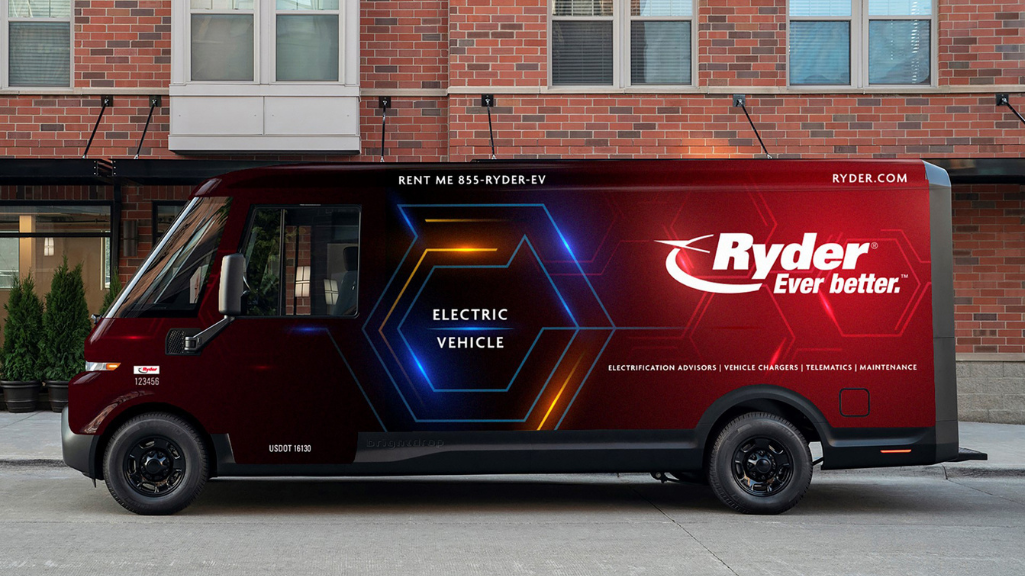 Ryder System, Inc. (NYSE: R), a leader in supply chain, dedicated transportation, and fleet management solutions, releases a quantitative analysis of the potential economic impacts of converting commercial diesel vehicles to electric vehicles (EV) in today’s market.
Ryder System, Inc. (NYSE: R), a leader in supply chain, dedicated transportation, and fleet management solutions, releases a quantitative analysis of the potential economic impacts of converting commercial diesel vehicles to electric vehicles (EV) in today’s market.
As one of the largest and longest-running fleet owners in North America, with more than 90 years of experience in transportation, Ryder manages a fleet of nearly 250,000 commercial vehicles. The company has introduced EVs into its lease and rental fleets and continues to work with multiple vehicle manufacturers to provide new electric solutions to customers. Ryder also recently launched RyderElectric+, which provides electrification advisors, vehicles, charging, telematics, and maintenance to help facilitate the seamless adoption of EVs.
 With evolving state and federal legal requirements aimed at transitioning fleets to zero-emission vehicles, Ryder customers frequently ask about the costs, benefits, and complexities of converting to electric – as EV technology and charging infrastructure are still developing. As a result, Ryder published “Charged Logistics: The Cost of Electric Vehicle Conversion for U.S.
With evolving state and federal legal requirements aimed at transitioning fleets to zero-emission vehicles, Ryder customers frequently ask about the costs, benefits, and complexities of converting to electric – as EV technology and charging infrastructure are still developing. As a result, Ryder published “Charged Logistics: The Cost of Electric Vehicle Conversion for U.S.
Based on representative network loads and routes from Ryder’s dedicated fleet operations in today’s market and other factors, the data shows the annual total cost to transport (TCT) by EV versus diesel is estimated to increase across the board – ranging from up to 5% for a light-duty transit van to as much as 114% for a heavy-duty tractor (depending on the geographic area). And, for a mixed fleet of 25 light-, medium- and heavy-duty vehicles, the analysis shows an increased TCT of up to 67% for an all-electric fleet.

Robert Sanchez, CEO
“While Ryder is actively deploying EVs and charging infrastructure where it makes sense for customers today, we are not seeing significant adoption of this technology,” says Robert Sanchez, chairman and CEO of Ryder.
“For many of our customers, the business case for converting to EV technology just isn’t there yet, given the limitations of the technology and lack of sufficient charging infrastructure. With regulations continuing to evolve, we wanted to better understand the potential impacts to businesses and consumers if companies were required to transition to EV in today’s market.”
Methodology
Ryder examined the TCT for diesel engines versus electric technology in the light-, medium-, and heavy-duty vehicle classes. The analysis is based on representative network loads and routes from Ryder’s dedicated fleet operations, which includes more than 13,000 commercial vehicles and professional drivers. It factors in the cost of the vehicle, maintenance, drivers, range, payload, and diesel fuel versus electricity, while also accounting for EV charging time and equivalent delivery times. The analysis also assumes the accessibility and use of the fastest applicable commercial vehicle chargers – though this network infrastructure is not yet built out.
First, Ryder conducted one-to-one comparisons for diesel and EV transit vans, straight trucks, and heavy-duty tractors, using cost assumptions from California, which typically has the highest fuel, electricity, and labor costs in the country, and in Georgia, where costs are generally lower.
Second, as most companies have more than one vehicle, Ryder applied the individual costs to a fleet of 25 vehicles of mixed classes and types, and compared the cost of owning and operating that fleet in California and Georgia. The fleet mix is based on the overall mix of commercial vehicles in the U.S., according to third-party data (Polk Data Services), and includes 11 light-duty vans, four medium-duty straight trucks, and 10 heavy-duty tractors.
TCT Impact in Georgia: One-to-One Comparison
In Georgia, Ryder conducted the same one-to-one comparisons. However, the variance in TCT for a diesel vehicle versus an EV is greater. Operating EVs in Georgia results in a higher cost disadvantage than in California, because Georgia’s lower fuel and energy costs do not provide the same level of savings when transitioning from fuel to electricity.
- A light-duty EV transit van (Class 4) shows an annual TCT increase of approximately 5% or nearly $8,000. While the vehicle and labor cost increases remain approximately the same, at 71% and 20%, respectively, fuel versus energy costs decrease 91% and maintenance decreases 22%.
- For a medium-duty EV straight truck (Class 6), the annual TCT increases to just under 28% or more than $53,000. The vehicle cost increases 216%, which is only partially offset by a 60% savings in fuel versus energy costs and 22% savings on maintenance.
- And, for a heavy-duty EV tractor (Class 8), the annual TCT increases by nearly 114% or more than $330,000. Vehicle cost remains the largest contributor, representing an increase of approximately 500%, followed by other operating costs that increase 87%, and labor and other personnel costs that increase 79% and 76%, respectively. Fuel versus energy savings are approximately 48%. Again, this assumes delivery times equivalent to a diesel vehicle and factors payload and range limitations as well as EV charging time – all of which requires nearly two heavy-duty EV tractors (1.87) and more than two drivers (2.07) to equal the output of one heavy-duty diesel tractor (which requires 1.2 drivers on average).
TCT Impact in California and Georgia: Mixed Fleet
Ryder then applied the TCT for individual vehicles to a mixed fleet of 25 light-, medium-, and heavy-duty commercial vehicles operating in California versus Georgia, including the assumption that a company would need nearly two heavy-duty EV tractors and more than two drivers to haul the same load on the same route as one heavy-duty diesel tractor.
In this scenario, a company converting 10 heavy-duty diesel tractors would need nearly 19 EVs and 21 drivers in order to provide the same level of service. This increases the total number of vehicles in the fleet from 25 to nearly 34 and drivers from 27 to nearly 36. Therefore:
- To convert a mixed fleet of vehicles in California to EV, the TCT would increase nearly 56% or more than $3.4 million.
- To convert the same fleet in Georgia, the TCT would increase approximately 67% or just more than $3.6 million.
Inflationary Impact
Ryder’s analysis also considers the potential inflationary impact if companies were required to convert to electric vehicles today. Based on the TCT for a mixed EV fleet, and assuming companies pass the increased TCT on to consumers, Ryder estimates those increases could cumulatively add 0.5% to 1% to overall inflation.
Key Takeaways

Karen Jones, EVP & Head of Product
“There are specific applications where EV adoption makes sense today, but the use cases are still limited. Yet we’re facing regulations aimed at accelerating broader EV adoption when the technology and infrastructure are still developing,” says Karen Jones, EVP and head of new product development for Ryder. “Until the gap in TCT for heavier duty vehicles is narrowed or closed, we cannot expect many companies to make the transition; and, if required to convert in today’s market, we face more supply chain disruptions, transportation cost increases, and additional inflationary pressure.”
“While mass adoption of EVs is not being required at this time, the purpose of this analysis was to quantify the gap in the total cost to transport goods with diesel versus electric vehicles and to understand what it will take to make commercial EVs economically viable at scale,” adds Sanchez. “Today, it would require significant advancements in EV technology to improve range and payload, and according to at least one industry estimate, nearly $1 trillion in charging infrastructure and power grid upgrades. While EV technology is still evolving, we are evaluating multiple ways to reduce emissions, including electric, natural gas, hydrogen, hybrids, and carbon capture, as well as continuing to advance diesel emissions technology. When a new technology is ready for the market, it has been our experience that businesses will see the benefits and broader adoption will follow.”
For a complete copy of the analysis and further insights from Ryder on the road to electrification, download a copy of “Charged Logistics: The Cost of Electric Vehicle Conversion for U.S. Commercial Fleets” go to ryder.com/evtct.

